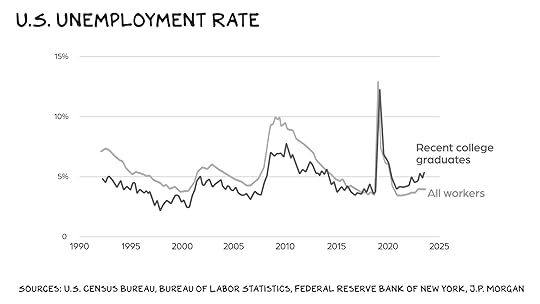How Does the End Begin?
The top 10 stocks in the S&P 500 account for 40% of the index’s market cap. Since ChatGPT launched in November 2022, AI-related stocks have registered 75% of S&P 500 returns, 80% of earnings growth, and 90% of capital spending growth. Meanwhile, AI investments accounted for nearly 92% of the U.S. GDP growth this year. Without those AI investments, Harvard economist Jason Furman noted, growth would be flat. As Ruchir Sharma concluded in the Financial Times, “America is now one big bet on AI,” adding, “AI better deliver for the U.S., or its economy and markets will lose the one leg they are now standing on.” This concentration creates fragility, and how the end begins becomes more visible.

I’m especially proud of the above header, and there is a connection. The S&P, Nasdaq, and DJIA are some of the most damaging metrics in modern history as they create the illusion of prosperity, even as depravity rages on. The cloud cover for a masked, secret police terrorizing communities is these indices. As long as your 401(k) is going up, then everything must make sense and be okay, no? No. Trump could not send troops into U.S. cities if the S&P were down, vs. up, 13%. AI stocks, and the sugar high they have inspired across the entire market, numb Americans from the nagging tooth pain that we are descending into fascism. Yeah, those evil people who wipe your grandma’s ass, pick our crops, and build our homes can be treated inhumanely as long as Nvidia remains worth more than the entire German stock market.
Trillion-Dollar QuestionValuations for the Mag 10 — the original group of seven leading tech stocks, plus AMD, Broadcom, and Palantir — are high, but not yet at historic peaks. The 24-month forward P/E ratio of the Mag 10 is 35x. In 2000, at the height of the dot-com bubble, the top 10 stocks traded at 52x forward earnings. Implicit in these valuations, however, is an assumption that AI will help these companies cut costs, or grow revenues by $1 trillion in the next two years. I believe we’re either going to see a massive destruction in valuations, infecting all U.S. stocks and global markets. Or we’re going to see a massive destruction in employment across industries with the highest concentrations of white-collar workers. Both scenarios are ugly.
If Mag 10 valuations are cut in half, the S&P and global markets would decline by 20% and 10%, respectively. In the U.S., the immediate impact would be felt by the wealthiest 10%, who own 87% of the stocks. Those households won’t struggle to pay their bills, but they may be the tail of the whip on the economy, as wealthy households have the luxury of decreasing their spending dramatically, vs. middle-class households, who spend the majority of their income on basics. If the top 10%, who account for half the consumer spending in the U.S., hit the brakes, the nation gets whiplash. I estimate that if the wealthy see their portfolios drop by 20%, we could see a 2-3% decline in GDP. For context: From peak to trough, the Great Recession registered a 4.3% drop in GDP.
If the Mag 10 justify their valuations by delivering $1 trillion in cost-cutting (Latin for “layoffs”), the impact will hit white-collar workers first, but the contagion could spread. Assuming an average white-collar wage of $100,000 per year, that’s 10 million jobs lost and a 6% increase in unemployment. That estimate is conservative compared to the “white-collar bloodbath” predicted by Anthropic CEO Dario Amodei, who told Axios, “AI could wipe out half of all entry-level white-collar jobs — and spike unemployment 10%–20% in the next one to five years.” The IMF warns that 60% of jobs are already exposed to AI in advanced economies and 40% in emerging markets. According to Okun’s Law, for every 1 percentage point increase in the unemployment rate, real GDP falls by approximately 2 percentage points. But AI could be a different story, with some experts predicting jobless growth. According to a J.P. Morgan report, AI may do to white-collar work what automation did to middle-skill jobs like sales, manufacturing, and construction in the 1980s. The canary in the coal mine may be recent college graduates. Stanford economists found that early-career workers (ages 22 to 25) in the most AI-exposed jobs have experienced a 13% relative decline in employment. If this trend accelerates, today’s challenges around wealth inequality and political volatility will seem quaint.
 Past Bubbles
Past BubblesA 2018 study that examined 51 innovations between 1825 and 2000 found 37 were accompanied by bubbles. The destruction that followed in each bubble’s wake, however, varied greatly, depending on several factors. Bubbles inflated by political policies are more destructive than those inflated by new technologies, according to economic historians William Quinn and John Turner. The size of the capital investment is also important. British railway investment in the 1840s was 15%–20% of GDP. When that bubble burst, unemployment doubled. In the U.S., railroad capex averaged 2.4% of GDP in the 1870s. That bubble drove the financial panic of 1873. In both cases, however, those investments paid (delayed) dividends in the form of rail capacity that helped distribute the promise of the Industrial Revolution. In contrast, as The Economist noted, the capex by electronics firms in the 1980s fueled Japan’s asset price bubble, but the spending “ultimately served no useful function.” Finally, the severity of a crash depends on who takes the losses. A second British rail bubble in the 1860s hit banks hard. The recent NFT bubble was a case study in the greater fool theory, but the contagion didn’t reach the broader economy.
Bubble Trouble?You can’t predict when/if a bubble will burst, but Azeem Azhar, founder of Exponential View, and researcher Nathan Warren, created a framework that compares historic bubbles with AI today. In their estimation, AI is a boom, but “booms can sour quickly and there are several pressure points worth watching.” If AI capex exceeds 2% of GDP, that’s cause for concern; it’s currently estimated at around 1.3%. A sustained fall in enterprise or consumer spending levels is another pressure point. A flawed, though perhaps directionally correct MIT study, rattled the AI ecosystem claiming that 95% of firms have yet to see measurable ROI from their AI pilot programs. We’re approaching a valuation redline if/when P/E ratios reach the 50x to 60x range. Finally, if internal cash covers less than 25% of capex, Azhar and Warren believe investments in data centers will come under pressure.

The AI infrastructure build-out has accelerated recently with an estimated $1 trillion in new commitments. Some firms are making deals with money and assets that don’t yet exist. See: OpenAI promising Oracle $300 billion — money it doesn’t have — for infrastructure Oracle hasn’t built. In other cases, revenue comes from “circular financing,” where dollars rotate between firms, obscuring true market demand. See: Nvidia’s $100 billion investment in OpenAI, which OpenAI will use to buy … Nvidia chips. Circular financing deals were common toward the end of the dot-com bubble, when similar deals contributed to a crash that destroyed 77% of Nasdaq market value. If we are on the precipice of a bubble popping, Nvidia and OpenAI will likely be ground zero. But the fallout would be widespread, as an ecosystem that resembles an ouroboros lives and dies by a shared narrative.

In his book Irrational Exuberance Robert Shiller wrote, “The word ‘bubble’ creates a mental picture of an expanding soap bubble, which is destined to pop suddenly and irrevocably. But speculative bubbles are as easily ended; indeed, they may deflate somewhat, as the story changes, and then reflate.” The operative word is “story.” Entrepreneurs, aka storytellers, deploy narratives to capture imaginations and capital in order to pull the future forward. Valuations aren’t a function of balance sheets, but of the stories that give those balance sheets meaning and direction. In the case of AI, a key storyline is shifting. A Prof G analysis of ChatGPT data found that work-related prompts fell from 47% in 2022 to 27% in 2025; ChatGPT has 76% market share. As my Markets cohost Ed Elson said, “the bull case for AI is that it’s going to transform work, but what we’re learning is it’s mostly just affecting your personal life.”
The trouble isn’t the shifting narrative, but the fragility of America’s bet on AI and wealthy consumers driving growth. If McDonald’s goes out of business, the fast-food industry will continue to meet demand for cheap calories; the industry is robust (i.e., anti-fragile). J.P. Morgan, now worth more than the 10 biggest banks in the EU combined, is too big to fail. America’s bet on AI is now a bet without hedge. If companies that aren’t the Mag 10 (i.e., the S&P 490) report they’re scaling back AI investments as the adoption layer fails to launch, the connective tissue between AI, trillions in market cap, and the broader economy severs. The experts have already deemed the grid and electrons as the gating factor to our AI future. However, they’re ignoring a more glaring possibility: AI may be more like VR than GPS and just not offer the ROI built into these valuations. Also, citizens burned by tech executives writing books on gender balance as they launch products that result in teen girls cutting themselves may decide character AI and porn are disastrous for our sons.
If China’s AI program produces another “Sputnik moment” similar to DeepSeek earlier this year, valuations for U.S. AI firms could tumble. And if reports including Apple’s “The Illusion of Thinking” extinguish the hope that artificial general intelligence is near, AI, and by extension the American economy, may experience a significant correction. We’re the biggest economy in the world and the most powerful nation in history. However, concentrating wealth in so few hands, betting on so few companies, makes us fragile.

When asked what one piece of advice I’d give young people, I offer “Nothing is as good or as bad as it seems.” Our economy rests on the belief that AI is even better than it seems. Careful…
Life is so rich,

P.S. For Prof G Conversations I spoke with Kai Ryssdal, host and senior editor of Marketplace. We discussed the risk of stagflation, the growing divide between the top 10% and everyone else, and why America’s economic strength still depends on the health of its democratic institutions. Listen here, and watch here.
The post How Does the End Begin? appeared first on No Mercy / No Malice.
Scott Galloway's Blog
- Scott Galloway's profile
- 1725 followers



